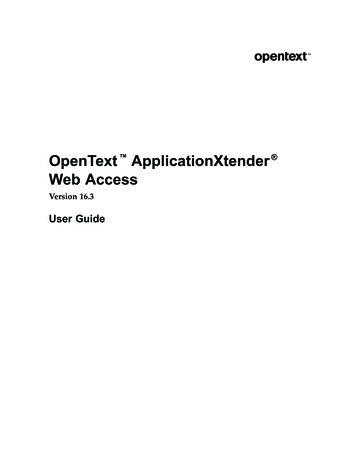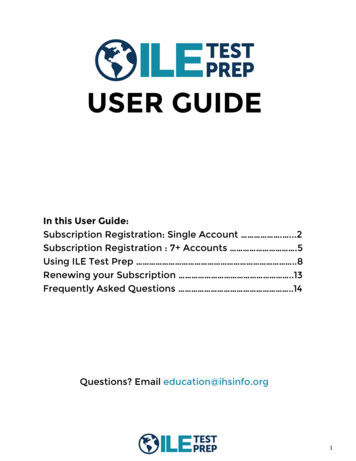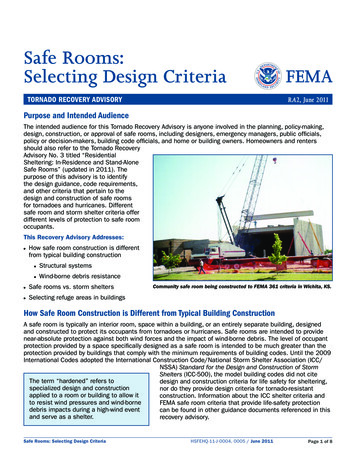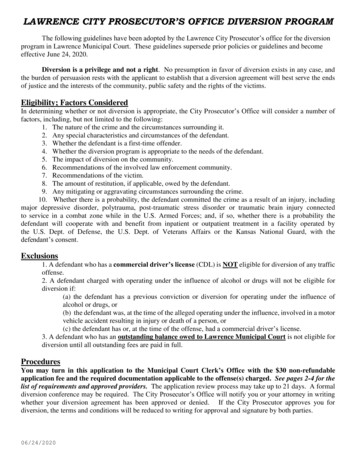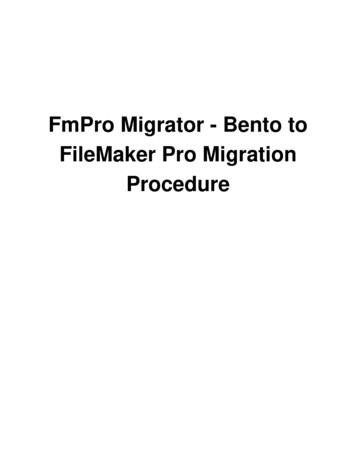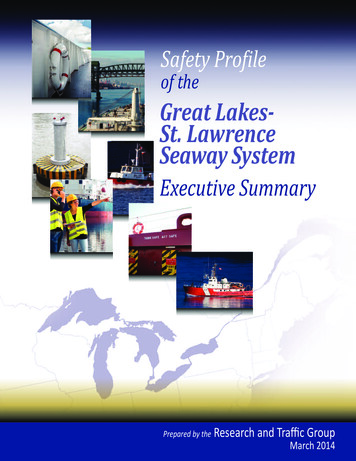
Transcription
Safety Profileof theGreat LakesSt. LawrenceSeaway SystemExecutive SummaryPrepared by the Research and Traffic GroupMarch 2014
Safety Profileof theGreat LakesSt. LawrenceSeaway SystemExecutive SummaryPrepared by theRESEARCH AND TRAFFIC GROUPGordon English, PartnerDavid Hackston, PartnerCapt. John Greenway (Associate)Capt. Randolph Helland, USCG ret. (Associate)March 2014
About the Study AuthorsFor more than two decades, Research and Traffic Group has provided advice and assistance to clients, and undertaken importantstudies, particularly in transportation. Brief resumes of the qualifications and experience of the Partners and Associates involvedin this safety profile are provided below:Gordon English (B.Sc., M.B.A., P.Eng.)Gordon English has been a partner at Research and Traffic Group since 1999, and an active associate since 1994, leading projectsfocused on energy, safety and techno-economic feasibility evaluations, including five climate change evaluations, fourenergy/emissions modal comparison projects, several transportation safety impact assessments and a discussion paper oninternalizing social costs in the transportation sector. English has more than 37 years’ experience conducting transportationrelated research. He is also currently the President of TranSys Research Ltd, which has focused on safety and techno-economicanalyses for projects such as the economic viability of railway operations in an asset devolution assessment for the St. LawrenceSeaway and recommendations to the Republic of China on proposals for high-speed rail passenger service between Taipei andKaohsiung. He also previously worked as the Director of Research for the Canadian Transportation Safety Board Act ReviewCommission and in various positions at the Canadian Institute of Guided Ground Transport at Queen’s University.David C. Hackston (B.Comm., B.Arts, FCILT)David Hackston has been a partner at Research and Traffic Group since 1988, assisting clients with analyses related to railtransportation, intermodal and Great Lakes-Seaway issues. He has more than 40 years’ experience in the transportation sector,including providing the Canada Transportation Act Review with expert advice on rail freight and passenger (intercity and urban)issues. From 1974 to 1987, he served with the Canadian Transport Commission as Executive Director, Traffic and Tariffs, advisingon rates and public interest issues for rail, motor vehicle and marine (Great Lakes and Northern Resupply). As chairman of the AdHoc Rates Committee and of the Sub Committee on Data, he advised on the drafting of the Western Grain Transportation Act andrepresented the CTC on the Steering Committee overseeing Transport Canada’s review of the Atlantic Region Freight Assistanceprogram. He also managed and conducted studies into various aspects of Canadian transportation flowing from initiatives agreedupon at the Western Economic Opportunities Conference, as well as the relationship between transportation and variousCanadian industries. This followed a nine-year career in the marketing and sales department of CP Rail.iiAbout the Study Authors
Captain Randolph Helland, USCG (ret.)Captain Helland held senior executive positions over a 32-year U.S. Coast Guard career at the national, regional and local levels inthe areas of marine/port safety, security, environmental protection and waterways management. Specific positions he heldduring his Coast Guard career included Chief, Marine Safety, Security and Environmental Protection for the Ninth Coast GuardDistrict (Great Lakes), Captain of the Port, Detroit, MI, Co-Chair Regional Response Team for Region V (Great Lakes), and Co-Chairof the U.S./Canadian Joint Response Team. After his Coast Guard career, he has consulted for companies conducting PortVulnerability Assessments, Trade Resumption/Business Continuity plans, and marine safety and navigation projects aroundthe U.S.Captain John GreenwayCaptain Greenway attained his Master’s certification and command experience on Great Lakes and East Coast Canadian ships.After a 12-year sailing career, he held various marine management positions with Upper Lakes Shipping (Hull – Superintendent,Fleet Superintendent – Operations, and General Manager- Operations). From 2004 to 2010, he served as Vice President –Operations with Seaway Marine Transport and retired in 2011. His involvement in marine regulatory matters has includedindustry representation with Transport Canada Marine Safety, the Canadian Coast Guard, the Great Lakes Pilotage Authority, theLaurentian Pilotage Authority and the Atlantic Pilotage Authority. Captain Greenway is a recipient of the Transport Canada“Marine Safety Award” which recognized his contribution to marine safety in Canada as well as a recipient of Georgian College’sGovernors Award for his contribution to marine training in Ontario and to the Canadian marine industry.About the Study Authorsiii
AcknowledgmentsThe study, Safety Profile of the Great Lakes-St. Lawrence Seaway System, was commissioned and produced in collaboration withthe Chamber of Marine Commerce.To our knowledge, this is the first time that the safety framework and safety performance has been documented and reportedacross the entire bi-national Great Lakes-St. Lawrence Seaway System. This report provides a comprehensive account of the keyelements of the safety framework currently in place throughout the bi-national navigation system — from regulations and therole of government, vessel construction and inspection, and mariner training — to shipowner and workplace safety programs,advanced navigation technology and emergency response capabilities.The report also provides the navigation community, transportation planners, government policy makers and the general publicwith a statistical assessment of the safety performance and spills record of vessels operating in these waters.The authors would like to thank the Chamber of Marine Commerce, the St. Lawrence Seaway Corporations and the marinecarriers for providing valuable input and operating data in the preparation of this report.We commend the Great Lakes-Seaway marine industry for their efforts to provide this safety profile that builds on prior works tobenchmark the marine industry’s environmental performance and quantify its economic impacts.Gordon EnglishPartner, Research and Traffic GroupDavid C. HackstonPartner, Research and Traffic GroupivAcknowledgments
Executive SummaryLakeSuperiorSault Ste MarieSoo LocksLake MichiganOver the years, the waterway has evolved.The Welland Canal connected Lake Ontario andLake Erie, enabling vessels to bypass Niagara Falls.The Soo Locks connected Lake Superior with LakeHuron and the St. Lawrence Seaway allowed vesselsto sail from Lake Ontario to the Atlantic Ocean.Figure ES1. Great Lakes-St. Lawrence Seaway SystemST. MARY’S RIVERST. LAWRENCE RIVERMontrealnuroeHLakThe Great Lakes and St. Lawrence River togetherform a critical path for the flow of commerce andessential raw materials for North America’smanufacturing and agriculture centers. Shipshave been transporting goods along the Lakes andtheir connecting tributaries for more than twocenturies and the maritime industry has playedan integral role in the economic and socialdevelopment of the region.CornwallMLO LocksMassenaHalifaxLake OntarioST. CLAIR RIVERDETROIT RIVERSarniae ErLakWelland CanalieThe resulting navigation system — the longest inland, deep-draft marine highway in the world — supports the activities of morethan 100 ports and commercial docks. American and Canadian domestic ships and international ocean-going vessels carry morethan 160 million tons of cargo via the waterway each year. This activity generates 35 billion in business revenues and supports227,000 jobs in Canada and the U.S.1While this economic contribution is vital to the prosperity of the region, the marine shipping industry recognizes that it must bebalanced against the protection of people, property and the environment. This waterway is a precious resource that is sharedamong many. It is the largest freshwater body in the world; a source of drinking water for 40 million people, and a recreationalplayground for nature and fishing enthusiasts, boaters, tourists and cottage owners alike. It is also uniquely shared by twonations, and regulated and protected by international treaties (such as the Boundary Waters Treaty of 1909), U.S.-Canadianbinational commissions (such as the International Joint Commission, which regulates water uses and environmental issues), andtwo federal, two provincial and eight state governments.Against this backdrop, it is not surprising that an innovative and multi-layered safety regime for the Great Lakes-St. LawrenceSeaway System (Great Lakes-Seaway) has developed that builds on the standards in place for international waters.This report, for the first time, measures safety performance across the entire bi-national Great Lakes-Seaway. It provides acomprehensive account of the bi-national safety framework currently in place throughout the navigation system — fromregulations and the role of government, vessel construction and inspection, and mariner training — to shipowner and workplacesafety programs, advanced navigation technology and emergency response capabilities.It also provides the navigation community, transportation planners, government policy makers and the general public witha statistical assessment of the safety and environmental performance and spills record of vessels operating in these waters.1 Source: The Economic Impacts of the Great Lakes-St. Lawrence Seaway System, Martin Associates, October 2011Executive Summary1
Key Elements of the Marine Safety Framework1. Government regulation is extensive Due to its bi-national nature, the Great Lakes-Seaway is unlike any other waterway system in the world. The safetyregime is anchored by a comprehensive structure of regulations that begins with a well-established internationalframework for the governance of vessel design and operations led by the International Maritime Organization (IMO).Canadian and U.S. agencies monitor and enforce these standards for any vessel entering their territorial waters andadopt or adapt these regulations for their own domestic fleets. Transport Canada and the U.S. Coast Guard (USCG) arethe principal agencies in each country charged with this task. While Transport Canada and the USCG are the core safety agencies, there are an additional 18 federal agencies as well asstate/provincial and local governments in the two nations involved in various aspects of marine safety.Figure ES2. Governmental Participation by Functional AreaFunctional Areas of Safety Responsibility/ParticipationAgenciesCanadian AgenciesTransport CanadaCanadian Coast GuardCanadian Border Services AgencyCanadian Hydrographic ServicesDepartment of National DefenceEnvironment CanadaHuman Resources and Skills DevelopmentLabour CanadaSt. Lawrence Seaway Management Corp.Transportation Safety BoardProvincial GovernmentsLocal GovernmentsU.S. AgenciesU.S. Coast GuardArmy Corps of EngineersCenters for Disease Control and PreventionCustoms and Border ProtectionDepartment of AgricultureDepartment of LaborEnvironmental Protection AgencyFederal Communications CommissionNational Oceanic andAtmospheric AdministrationSaint Lawrence Seaway Development CorpState GovernmentsLocal Governments2Ship Port/ Emergency Aids toIceSafety Facility Response Navigation BreakingXXXXXXXXXDredging/MarinerWaterSafety/ Licencing/Levels Environment Health Pilotage OtherXXXXXXXXXXXXXXXXXXXXXXXXXXXXXXXXXSafety Profile of the Great Lakes-St. Lawrence Seaway SystemXXXXXXXXXXXXXXXXXXXXX
The administration of the St. Lawrence Seaway’s infrastructure is shared by two entities: the Saint Lawrence SeawayDevelopment Corporation (SLSDC) in the U.S. — a federal agency within the U.S. Department of Transportation — and theSt. Lawrence Seaway Management Corporation (SLSMC) in Canada — a not-for-profit corporation. The two SeawayCorporations provide the regulatory framework for the inland navigation waterway under their respective jurisdictions,coordinate operational activities, particularly with respect to rules and regulations, and day-to-day operations of 15 locksbetween Montreal and Lake Erie, provide traffic management to ensure safe vessel transit, manage draft and waternavigation conditions, navigation aids, safety, environmental programs, operating dates and trade developmentprograms and provide management of certain land parcels adjoining the Seaway, owned by the U.S. and Canadianfederal governments.2. Ship regulations are enforced prior to entry into the Great Lakes-Seaway Before a foreign-flag ship even enters North American waters, it submits a “notice-of-arrival” to the MarineCommunications and Traffic Service in Halifax, Nova Scotia. The notice-of-arrival provides critical information thatincludes prior ports of call, destination port, cargo, and crew nationality. This information is then forwarded to theCanadian Coast Guard’s (CCG’s) Marine Security Operations Centre in Halifax, and further, to a joint Canadian-U.S.inspection team in Montreal and to the Seaway Corporations. If there is anything related to law enforcement or nationalsecurity, the Royal Canadian Mounted Police and/or Canada’s Department of National Defence will decide theappropriate steps to take, including whether to board the vessel. Foreign ships that are permitted in Canadian waters and enter the Great Lakes-Seaway are then subject to a series ofinspections to ensure compliance with domestic and international laws, and Seaway-specific regulations. Based in Montreal,a joint Canadian and U.S. team, including Transport Canada, the USCG and the Canadian and U.S. Seaway Corporations,inspect vessels to verify safety, security and pollution prevention requirements, as well as ballast water compliance. Possible enforcement actions against non-compliant vessels include preventing transit or the delay of cargo operationsuntil the deficiency is corrected; a monetary fine; or depending on the violation, pursuing criminal charges against thevessel owner, captain of the ship or another person in charge.3. Ships are tracked by advanced traffic control systems The Great Lakes shipping industry has been proactive in the development and adoption of satellite-navigationtechnology to improve safety, with the Seaway being the one of the first inland navigation systems to adopt an integratedvessel Automatic Identification System (AIS). Prior to the introduction of mandatory carriage of this modern equipment,Great Lakes operators were utilizing electronic charting, satellite positioning, and ship information-transmissiontechnology. Significant testing in its infancy and advancement of this navigation technology are credited to the pioneeringefforts of Great Lakes shipping companies. All vessels entering the Great Lakes-Seaway are monitored by vessel traffic control centers stationed throughout thesystem. Each vessel is required to have AIS technology as part of its navigation equipment. This technology sends out asignal to each of the vessel traffic centers and also shares important “real-time” navigational information with nearbyvessels, including the exact location, speed and course of each vessel. Every commercial vessel that transits the GreatLakes-Seaway can then be tracked electronically (through the AIS) when in the specified traffic control zones, and shorestations can communicate with the vessel by voice using Very High Frequency (VHF) radio. In the Seaway, ongoing realtime navigation information is used by vessels, providing key data that increases navigational safety by enabling marinersto proactively make decisions before a vessel reaches a dangerous point in its transit path.Executive Summary3
4. Vessel integrity and equipment are inspected during construction and throughout its lifespan Throughout its lifespan, a Great Lakes ship is subject to rigorous inspections and certification oversight — in the originaldesign and construction stage, through mandatory annual inspections, and through the “out of water” dry-dockinginspections undertaken on a five-year basis for domestic vessels and twice in every five-year period for internationalvessels. Regular inspection of vessels is performed by Transport Canada or the USCG or delegated to an approvedclassification society. These classification societies are subject to audit and verification by government authorities toensure compliance with all standards.5. Waterway depths and hazards are continuously monitored and managed The U.S. Army Corps of Engineers (USACE) ensures the safe passage of vessels in American waters by constructing andmaintaining navigation channels and harbors through dredging and regulation of water levels on inland waterways —including 47 deep-draft U.S. ports and 55 shallow-draft harbors. In addition, the USACE surveys the lakes; builds andmaintains 104 miles of breakwater; and operates and maintains 20 lock chambers and 20 confined disposal facilities fordredge materials. In the Seaway, both Corporations (SLSMC and SLSDC) ensure the safe passage of vessels in their jurisdictional waters byimplementing effective maximum vessel draft and speed management. The Canadian Hydrographic Service performs surveys of lakes, rivers and channel bottoms in Canadian waters to ensurethe accuracy of depths on navigation charts for safe navigation. The CCG has responsibility for dredging and maintainingsafe depths in specific identified navigational channels and Canadian ports are responsible for the dredging of theirharbors and navigation channels. Water levels are monitored in real time by water-level gauges owned and operated in U.S. waters by the NationalOceanic and Atmospheric Administration and USACE — and in Canadian waters, by the SLSMC, CCG and the CanadianHydrographic Service. Water-depth information is made available to the mariner via Internet, telephone and AISservices — to ensure up-to-date and accurate water-level readings that support safe navigation and route planning.6. The Great Lakes-Seaway is a compulsory pilotage zone Under Canadian and U.S. law, any ship entering the navigation system from overseas is required to hire a Canadian orAmerican pilot. Pilots are expert navigators who are familiar with local geography, weather, currents and sailingconditions. The pilot’s expertise supplements the captain’s expertise to ensure safe navigation. U.S. and Canadian domestic ships meet this requirement through demanding USCG licensing programs for U.S. deckofficers. Canadian deck officers follow a similar system through the Great Lakes Pilotage Authority’s Pilotage CertificationProgram. Extensive training, examination and assessment of skills, mandatory trips, valid marine officer credentials andrigorous physical examinations all support the knowledge, skills and capabilities of domestic mariners to conduct theirpilotage responsibilities.7. Mariners receive specialized training and are licensed by government authorities Commercial vessels operating on the Great Lakes-Seaway are under the control of professional mariners that have notonly received specialized training, but have also been licensed by government authorities. A ship’s captain, for example, willhave graduated from an accredited maritime academy or university program, and will have accumulated years ofexperience and passed a series of written and oral examinations before obtaining a Master’s (Captain’s) ticket. In theUnited States, licensing of merchant mariners is the responsibility of the USCG. In Canada, licensing is the responsibilityof Transport Canada.4Safety Profile of the Great Lakes-St. Lawrence Seaway System
In Canada and the U.S., becoming certified as a Master takes a minimum of between six and eight years and, given theneed for gaining necessary experience, often longer. Following certification, companies will often require Masters toserve on different ship types; conduct a period of sailing with “Training Masters”; complete additional training onsimulators for ship handling, pilotage and bridge resource management; and complete other management coursesbefore taking on command of a ship. A “Master-in-Training” often undergoes 6 to 12 months of additional onboardtraining under Training Masters, with formal assessments documented.8. Stringent tanker safety requirements are in place Liquid bulk cargo is transported on the Great Lakes-Seaway by Canadian, American and international vessel operators.Specially designed tank ships (self-propelled tankers) typically transport petroleum products and liquid chemicals. Tank barges(non-powered vessels pulled or pushed by a tug) are typically used to transport asphalt and heavy oil. The U.S. and Canadian governments have adopted environmental safety standards for new and existing petroleum-producttankers operating in Canadian or U.S. waters. These standards require that tankers be built to specific double-hulledstandards, resulting in a safety separation between the inner cargo compartments and the ship’s outer hull of between1 and 2 metres (3.3 to 6.6 ft.) depending on the deadweight tonnage (DWT) capacity of the tanker.2 All Canadian, American and international tanker ships operating on the Great Lakes-Seaway must be double hulled byJanuary 1, 2015.9. Emergency preparedness and response measures are continuously tested and evaluated The Great Lakes-Seaway marine industry works in partnership with federal, state/provincial and local governments todevelop contingency plans to be prepared in the event of marine emergencies. These plans are tested through regularemergency preparedness exercises involving vessels, Coast Guards, ports and the St. Lawrence Seaway Corporations. All vessels must have on board a detailed emergency plan, containment booms and other equipment to deal with possiblespills, as well as agreements with government-approved emergency response contractors to aid in clean-up, if required. In the event of a marine oil spill/emergency in Canada or the U.S., the Coast Guard (Canadian or U.S., depending onjurisdiction) is the first in line-of-command for oversight and response at a spill site. The Seaway Corporations, port andinfrastructure management agencies (e.g. for spills in harbors or in Seaway locks/channels) notify all relevant respondersand offer assistance in whatever way they can provide, including containment if they have local resources. Oil-responseorganizations are usually the first responders for spills and address containment and recovery activity. They operate underthe direction of the responsible party and fall under the jurisdiction of the Coast Guard, which may intervene if necessary. The responsible entity (usually a vessel owner) is liable for the costs incurred and generally has indemnity insurance inexcess of the minimum required to cover the costs of a major spill. If required, publicly administered Oil Pollution Fundsare available in both countries for payment to those incurring damage or containment costs. Recovery of the funds issought from the responsible entity and/or insurance company after the clean-up operations are completed. The Canada-United States Joint Marine Pollution Contingency Plan provides a coordinated system for planning, preparednessand response to harmful-substance incidents in the contiguous waters. The Joint Marine Pollution Contingency Plan andits Geographic Annexes (Area specific plans) augment the national response systems of Canada and the United States byproviding a “bridge” between the two systems — ensuring that coordinated planning is accomplished at the local level.2 The formula for the width of the space is W (in metres) 0.5 DWT/20,000 with a minimum space of 1.0 metres and a maximum of 2.0 metres.Executive Summary5
Safety Performance of the Great Lakes-Seaway Fleet1. Statistical AnalysisThe Great Lakes-Seaway fleet (Canadian, U.S. and international vessels) operates in Canadian and U.S. waters and the combinedactivity of these vessels can be isolated from that of other regions of the two countries. Marine safety data specific to the GreatLakes-Seaway was, therefore, collected from Canadian and U.S. government sources for the years 2002 to 2011.Data on marine accidents in Canada are reported to the Canadian Transportation Safety Board (TSB) and in the U.S., to the U.S.Coast Guard (USCG). Marine safety data for Canada was obtained from the TSB Marine Occurrences Database and for the U.S.,from the Marine Casualty and Pollution Database held by the National Technical Information Service. The Canadian TSB datawere segmented to include only those vessels that were making a trip into the Seaway. Thus, accidents occurring in the lowerSt. Lawrence River were included only if the vessel had an origin or destination west of Montreal.The marine reporting requirements include both transportation-related accidents and employee health- and safety-relatedaccidents when occurring aboard vessels. Marine transportation-related accidents include vessel events such as strikings,groundings and collisions. Therefore, the data can be segmented into transportation-related casualties and workplace-relatedcasualties.Spills in U.S. waters are reported to the USCG and the data are included in the same Marine Casualty and Pollution Databasecited above. Spills in Canadian waters are reported to the CCG and a 10-year (2002-2011) history of data was obtained foranalysis in this study. Spills were included if they occurred in the Great Lakes-Seaway — which covers the Seaway withinMontreal and all Great Lakes-Seaway waters west of Montreal. Much of the activity on the tributary rivers/canal systemsinvolves barges that operate strictly on the rivers and canals. Spills occurring on the tributary rivers, canals and harbors wereonly included if they involved a Great Lakes bulk cargo vessel or a barge of 2,000 gross registered tonnage (GRT) or higher.2. Public Safety RecordGreat Lakes-Seaway ships operating in Canada and the U.S.carried more than 1.5 billion metric tonnes of cargo over the10-year period (2002 to 2011) without any accidentsnegatively impacting public safety.There were a total of 801 reported vessel accidents and safetyoccurrences throughout the entire system in Canada and theU.S. over the period of 2002 to 2011. Most of the marineaccidents were minor in nature with 59% of the accidentsreported in U.S. waters resulting in no damage to the vesseland 97.5% of accidents reported in Canadian waters classifiedat the minimum severity ranking.Table ES1. Comparison of Marine and Rail Injuryand Fatality Rates for Transportationrelated Accidents (2002-2011)ModeRate per 100-billion tonne-kmMarine – Great Lakes-Seaway VesselsRail – Cdn Freight RailwaysRail – U.S. Class 1 Freight RailwaysRate per 100-billion ton-milesMarine – Great Lakes-Seaway VesselsRail – Cdn Freight RailwaysRail – U.S. Class 1 Freight 2.5910.200.940.95Source: RTG analysis of Canadian TSB accident data and Federal Railway AdministrationVessel collisions/strikings or groundings (transportationcasualty database and ton-mile data from the U.S. Department of Transport, Bureaurelated accidents) resulted in zero fatalities and injuries toof Transportation Statistics, Appendix D: Rail Profile.members of the public. Shipping accidents did result in twoinjuries to marine employees. Based on the total number of vessels trips made over the 10-year data interval, 100% of trips werefatality-free and 99.997% were injury free in relation to shipping accidents.The analysis shows that the rate of transportation-related injuries per 100-billion tonne-km for marine vessels in this region is17 times lower than the national rate for Canadian freight railways and 70 times lower than U.S. Class 1 freight railways. The railstatistics include casualties due to train derailments/collisions, highway grade crossing collisions and trespass collisions.6Safety Profile of the Great Lakes-St. Lawrence Seaway System
3. Workplace Safety RecordFor the 10-year period of 2002 to 2011, a total of 5 employee fatalities occurred while onboard vessels - 2 aboard Canadianflagged vessels and 3 aboard U.S.-flagged vessels.Analysis of Canadian and U.S. government records shows that Great Lakes-Seaway mariners have significantly lower employeefatality rates than other U.S. transportation and material-moving occupations, including rail, trucking and air cargo sectors. Overthe 10-year period 2002-2011, employee fatality rates were about 50% higher for rail transportation and 5.5 times higher forlong-distance trucking compared to Great Lakes-Seaway mariners.A similar workplace safety comparison against other Canadian freight modes was not possible due to a lack of consistent andcomparable government information.Figure ES3. Freight Transport Mode Employee Fatality Rates Per 100,000 workers (2002-2011)U.S. Long Distance Freight Truck26.70U.S. Transporta on and Warehousing Average15.60U.S. Scheduled Air Cargo7.45U.S. Rail Transporta on7.24Great Lakes-Seaway Mariners4.900.05.010.015.020.025.030.0Source: Fatality rates based on census data published by the U.S. Department of Labor, Bureau of Labor Statistics, Census of Fatal Occupational Injuries (2002-2011)Note 1: Marine casualties are those of the combined U.S. and Canadian waters of the Great Lakes-Seaway based on USCG and TSB data.Note 2: Employee workplace fatalities exclude 3 fatalities resulting from previously existing medical conditions that are reported in the marine data but are not included inthe chart as they are not “workplace casualties” as defined in normal labor statistics.4. Spills in Canadian and U.S. WatersSpills of dangerous goods in Canada and hazardousmaterials in the U.S. are reported to the respectiveCoast Guards. Analysis of the data shows that therewere 139 releases from vessels in the bi-nationalGreat Lakes-Seaway, over the period of 2002 to 2011.Spills were predominantly sma
After his Coast Guard career, he has consulted for companies conducting Port Vulnerability Assessments, Trade Resumption/Business Continuity plans, and marine safety and navigation projects around the U.S. Captain John Greenway Captain Greenway attained his Master's certification and command experience on Great Lakes and East Coast Canadian .
